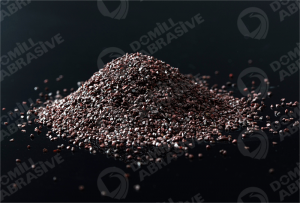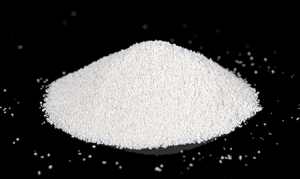Home / News & Blog / Abrasive Blog / Choosing the Right Abrasive Grains for Stone Sandblasting and How to Recycle Them
As someone with over 20 years of experience in the abrasive industry, I’ve seen how important it is to select the right abrasive material for stone sandblasting. The choice of abrasive grain not only determines the effectiveness of the process but also has a major impact on cost-efficiency and environmental sustainability. In this article, I’ll cover the most commonly used abrasive grains for stone sandblasting, discuss their strengths, and explain how to recycle them effectively to maximize their lifespan.
There are several types of abrasive grains that work well in stone sandblasting applications. Each has its unique properties, and knowing when and why to use each can greatly improve your sandblasting results.

Strengths: BFA is a hard, tough, and durable abrasive ideal for general-purpose sandblasting. It’s perfect for rougher stone surfaces, such as granite and concrete, where you need to remove large amounts of material quickly.
Best For: Large-scale cleaning and surface preparation of stone.
Recycling: BFA can typically be recycled up to 5 times due to its high wear resistance and chemical stability, making it an excellent choice for cost-effective, long-term use.

Strengths: WFA is known for its high purity and sharp edges, making it a good option for precision work and fine stone polishing. It’s great for projects where surface smoothness is key.
Best For: Fine sandblasting applications, like stone polishing and decorative effects.
Recycling: WFA has similar recyclability to BFA and can be reused about 5 times without a significant drop in performance.
![]()
Strengths: SiC is an extremely hard and sharp abrasive, ideal for aggressive sandblasting jobs. It’s highly effective for hard materials, making it the go-to choice for abrasive cleaning and etching stone.
Best For: Hard stone surfaces, such as ceramics or heavy-duty surface cleaning.
Recycling: While SiC is durable, its fragility means it doesn’t hold up as well with multiple uses. Typically, it can be recycled 3-5 times, but with more wear than BFA or WFA.
Strengths: Glass beads are gentler abrasives, making them ideal for fine, decorative work. They are used to provide a smooth and shiny finish on stone surfaces.
Best For: Surface finishing, decorative effects, and engraving on softer stones.
Recycling: Glass beads are less durable than other abrasives, typically lasting around 3-5 cycles before breaking down.
Strengths: Garnet is one of the best abrasives when it comes to recyclability and abrasion resistance. It offers excellent durability, making it ideal for general-purpose blasting tasks.
Best For: A versatile choice for surface cleaning and etching stone.
Recycling: Garnet is highly recyclable, typically lasting 5+ cycles, and is environmentally friendly.
Recycling abrasives is a critical part of maximizing the cost-effectiveness of sandblasting operations, while also reducing environmental impact. However, stone debris from the sandblasting process can mix with the abrasive grains, which complicates the recycling process. So, how do you handle this issue?
2.1 Using Dedicated Recovery Equipment
One of the best ways to recover abrasives is through specialized equipment designed to separate the abrasive from the stone dust.
Separation Systems: I’ve used systems like vibrating sieves and air separation units that help separate stone fragments from the abrasive grains. The vibrating sieves sort by particle size, while air separators use airflow to separate the lighter stone debris from the heavier abrasive grains.
Magnetic Separation: While BFA and WFA aren’t magnetic, you can use magnetic equipment to remove iron contaminants that might mix in during the sandblasting process, ensuring cleaner abrasives for reuse.
2.2 Size Classification and Sorting
Another key to effective abrasive recovery is ensuring that the particles are properly sorted.
Particle Size Control: To maintain consistent blasting results, it’s essential to separate larger stone fragments from smaller abrasive grains. By using the correct sieve mesh sizes, you can ensure that the recovered abrasives are of uniform size and quality.
Mechanical Screening: Using mechanical screening equipment ensures that the recovered abrasives meet the required particle size for optimal performance.
2.3 Regular Cleaning and Maintenance
Regular maintenance and cleaning of your equipment can go a long way in keeping the abrasives in good condition.
Cleaning Sandblasting Machines: By regularly cleaning out the machine and the blast area, you can prevent stone fragments from accumulating and mixing with abrasives.
Adding Filters: Many modern sandblasting systems include filtering devices that remove dust and stone fragments from the air, preventing them from contaminating the abrasive material.
2.4 Optimizing Sandblasting Parameters
One often-overlooked way to extend the life of your abrasives is by optimizing the sandblasting process itself.
Spray Pressure and Distance: Adjusting the pressure and distance of the spray can reduce stone fragmentation. The more controlled the blast, the less debris is created, which means your abrasives last longer.
Spray Timing: Managing how often you blast the material can also reduce unnecessary wear on the abrasives, allowing you to reuse them more effectively.
2.5 Wet Recovery Methods
For more thorough cleaning, wet recovery systems can be a game-changer.
How it Works: Water can help separate heavier abrasive grains from lighter stone fragments, making it easier to recover and reuse them. The wet method can be highly effective, but it requires specialized equipment that can handle water and slurry.
Garnet is an excellent option for stone sandblasting due to its high hardness, low fragmentation, and recyclability.
Hardness and Durability: Garnet particles are highly durable and can withstand multiple cycles of sandblasting without significant degradation. This makes it an ideal choice for applications where abrasives need to perform well over several uses.
Recyclability: Garnet’s low breakage rate means it can typically be recycled 5+ times, unlike more fragile abrasives like SiC.
Eco-Friendly: Garnet is a natural, non-toxic abrasive, and unlike other materials, it produces very little dust, making it safer for workers and the environment.
Choosing the right abrasive for stone sandblasting is just the beginning. To maximize your operations, you need to understand how to recycle abrasives effectively. Brown Fused Alumina and White Fused Alumina are excellent choices due to their durability and high recyclability. Along with optimizing your sandblasting process, using the right recovery techniques can help reduce costs, improve efficiency, and make your operations more sustainable.
At DOMILL ABRASIVE, we specialize in high-quality abrasives like BFA and WFA that are designed for high-performance applications. Let us help you get the most out of your abrasive materials – contact us today to learn more about how we can support your sandblasting needs.